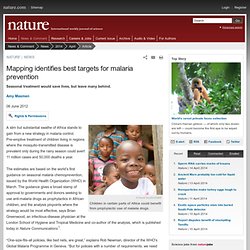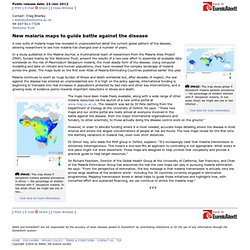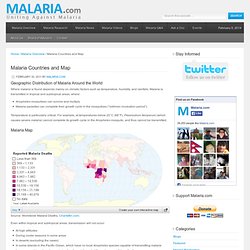

IR Mapper: mapping insecticide resistance in malaria vectors. MAP Data Explorer. Global Health Observatory. Mapping identifies best targets for malaria prevention. © David Snyder/ZUMA Children in certain parts of Africa could benefit from prophylactic use of malaria drugs.

A slim but substantial swathe of Africa stands to gain from a new strategy in malaria control. Pre-emptive treatment of children living in regions where the mosquito-transmitted disease is prevalent only during the rainy season could avert 11 million cases and 50,000 deaths a year. The estimates are based on the world’s first guidance on seasonal malaria chemoprevention, issued by the World Health Organization (WHO) in March.
The guidance gives a broad stamp of approval to governments and donors seeking to use anti-malaria drugs as prophylactics in African children, and the analysis pinpoints where the strategy would be most effective, says Brian Greenwood, an infectious-disease physician at the London School of Hygiene and Tropical Medicine and co-author of the analysis, which is published today in Nature Communications1. from Ref 1. We Can End Malaria. Drugs and Diagnostics The current treatment for malaria is artemisinin-based combination therapies (ACTs).

ACTs are effective and are well-tolerated by patients, but because of their high cost, patients often purchase cheaper, less-effective drugs, poor-quality drugs, or counterfeits, all of which can increase the risk that drug-resistant strains of malaria will emerge. Resistance has already been observed in Southeast Asia.
A nurse dispenses a malaria drug to treat an infected child in Tanzania To improve the availability of treatments and eventually develop a single-dose cure for malaria, it is important to diversify the drug pipeline and invest in the discovery and development of effective non-artemisinin-based treatments. Our strategy supports the effective delivery of ACTs, the elimination of artemisinin resistance, and the discovery of novel malaria drugs. Our investments include: Vector-Control Tools Vaccines Integrated Interventions Advocacy, Policy, and Financing.
MARA/ARMA Project Home Page. Malaria - Travelers - CDC Malaria Map Application. Skip directly to search Skip directly to A to Z list Skip directly to navigation Skip directly to site content Skip directly to page options CDC Home CDC 24/7: Saving Lives. Protecting People.™ <div class="noscript"> Note: Javascript is disabled or is not supported by your browser.
Home - Fit For Travel. CDC Malaria Map Application. Data visualisation. Malaria Hotspots - Interactive malaria map. New malaria maps to guide battle against the disease. Public release date: 23-Jan-2012 [ Print | E-mail Share ] [ Close Window ] Contact: Craig Brierleyc.brierley@wellcome.ac.uk 44-207-611-7329Wellcome Trust A new suite of malaria maps has revealed in unprecedented detail the current global pattern of the disease, allowing researchers to see how malaria has changed over a number of years.

In a study published in the Malaria Journal, a multinational team of researchers from the Malaria Atlas Project (MAP), funded mainly by the Wellcome Trust, present the results of a two-year effort to assemble all available data worldwide on the risk of Plasmodium falciparum malaria, the most deadly form of the disease. Using computer modelling and data on climate and human populations, they have revealed the complex landscape of malaria across the globe. The maps have been made freely available, along with a wide range of other malaria resources via the launch of a new online portal at www.map.ox.ac.uk. . [ Print | E-mail AAAS and EurekAlert!
Malaria Atlas Project. MAP Data Explorer. Global Malaria. Global Malaria (dark) Malaria Elimination Group. Malaria Countries and Map. Geographic Distribution of Malaria Around the World Where malaria is found depends mainly on climatic factors such as temperature, humidity, and rainfalls.

Malaria is transmitted in tropical and subtropical areas, where: Anopheles mosquitoes can survive and multiplyMalaria parasites can complete their growth cycle in the mosquitoes (“extrinsic incubation period”). Temperature is particularly critical. For example, at temperatures below 20°C (68°F), Plasmodium falciparum (which causes severe malaria) cannot complete its growth cycle in the Anopheles mosquito, and thus cannot be transmitted. Malaria Map Source: Worldwide Malaria Deaths, ChartsBin.com.
Even within tropical and subtropical areas, transmission will not occur: Generally, in warmer regions closer to the equator: Transmission will be more intenseMalaria is transmitted year-roundP. falciparum predominates. The highest transmission is found in Africa South of the Sahara. Source: Centers for Disease Control (CDC)